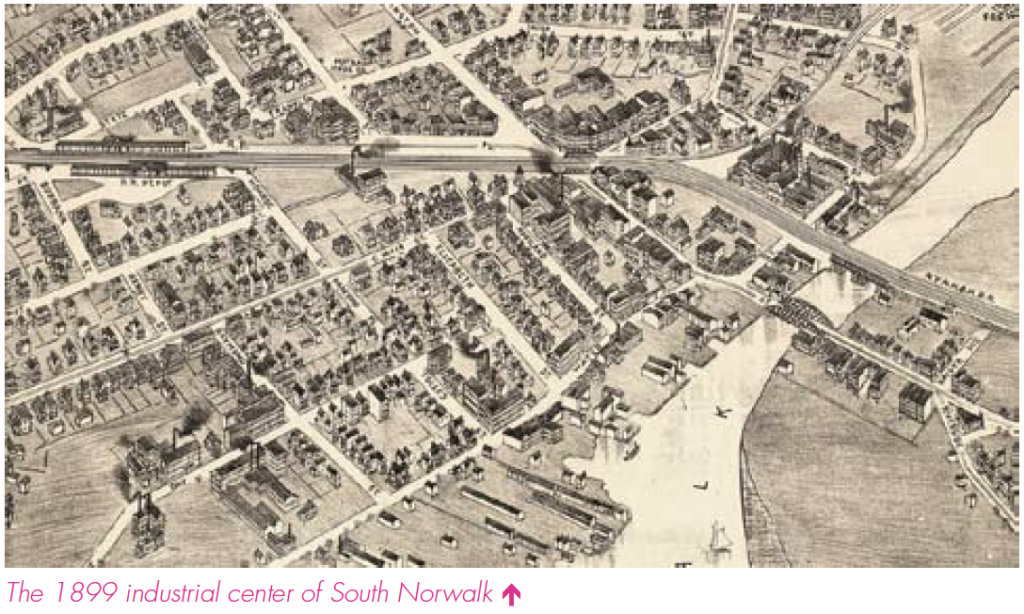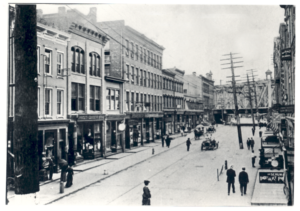Home > Norwalk History > Early Norwalk
Explore The History of Norwalk Neighborhoods

By Jackie Lightfield
Norwalk is a city of hundreds of neighborhoods, each benefiting from a style and vibe that meshes the here and now and the distant past. This makes sense, considering Norwalk’s colonial roots started around 360 years ago. Norwalk also has a distinct history of having survived some old-fashioned fire and water-based devastation, as well as once thriving as three separate towns.
All this leads to an interesting perspective on how much of Norwalk’s history can be seen in the architectural styles that mark the decades of bygone eras.
Our trip in the Wayback Machine begins, as the origins story goes, when Roger Ludlow, colonial dude, struck a deal involving some beads and stuff with the Norwacke Indians, and the first credit swap derivative real estate deal was done. Real colonial-era buildings are few and far between in Norwalk for a very good reason: they were made of wood.
Not long after Paul Revere’s famous ride announcing the British were coming, Connecticut experienced the British were burning. Norwalk’s fickle finger of fate was the almost complete wipeout of the town – about 8 buildings survived the 1779 burning. But there’s a nice collection of what that colonial-era might have looked like, at Mill Hill, at the corner of East Ave and Wall Street.
Heading down from Mill Hill along Wall Street, the colonial era gives way to the downtown melting pot of the 19th and 20th-century style brick buildings and postwar urban renewal buildings. It’s an interesting mix partly created after the great fire of 1858, which took out a bunch of wood buildings, and the great flood of 1955. Anchoring the far end of Wall Street is the Carnegie financed Norwalk Library, and along the way, you can admire the stalwart brick buildings mingling 1950s retail shop fronts and the incredible hulking banks, some even still banking.

A city with hundreds of neighborhoods of course just doesn’t have one downtown; in Norwalk’s case it has two. SoNo, a short jaunt down West Ave. is a nationally recognized historic district. SoNo is also home to some of the more eclectic architecture in Norwalk, beyond the world-cuisine restaurants and bars, tucked away in the 18th-century brick-clad buildings that line Washington Street.
Whether it’s the stately Lockwood Mathews Mansion displaying all sorts of architectural styles, favored by the rich back in the day, or the sprawling Victorians lining the roads up to Golden Hill, the South Norwalk area sweeps through decades of history. Post war apartment housing, beachside tiny cape codders, and the proliferation of the basic Brady Bunch ranch.

Norwalk’s industrial past can be seen in the factory buildings that are on Ann, Water, Washington, Haviland, and Meadow streets. Clusters of water view-inspired neighborhoods each represent a unique neighborhood style, whether it’s the graceful yet commanding homes in Shorefront Park or the tightly packed archipelago of Harbor View or Belle Island.
Completely off the beaten path and not far from Harbor View, Village Creek just recently earned its historic designation for its collection of mid-century modern houses, flat-roofed–big glass views of nature dominate. Not historic, but equally distinct Wilson Point collects large regal-looking houses along the Long Island Sound. A ride along route 136 earns you a view of Norwalk’s Industrial past former factories that hide the shoreline as well as conclaves of homes. A newly refurbished yellow brick former technical college speaks to the area’s industrial power. Route 136 will lead you to the five-mile river and the quaint maritime community of Rowayton with its mix of dockside buildings and fishing village charm.
Heading north, the range of neighborhoods includes the sinking 1980s-era development in former marshland and more mid-century modern gems tucked away in West Norwalk’s wooded area, and the river runs through it lots. Silvermine evokes a bygone era of an artist colony and not much in the way of silver mining. Across the river lies the north country areas like Cranbury where the Gallaher estate, now Cranbury Park, speaks to the era of farmland estates that once were peaceful retreats for industrialist chieftains.
East Norwalk, bordering Westport and south of route 1, is the third city that joined to form the city of Norwalk. Its legacy lies in its manufacturing past, with three former factories surrounded by worker housing built to house workers. Skirting the harbor are the old sidewalk and tree-lined neighborhoods that spark that nostalgic suburban 1950s feel. But closer to the beach, the houses grow larger and more stately as commanding views of Norwalk’s harbor, islands, and the Long Island Sound were the original draw.
Overall Norwalk presents every style of living, architecturally of course. Considering that Norwalk is the same size as Manhattan, the diverse neighborhoods are sure to stick around for decades to come.